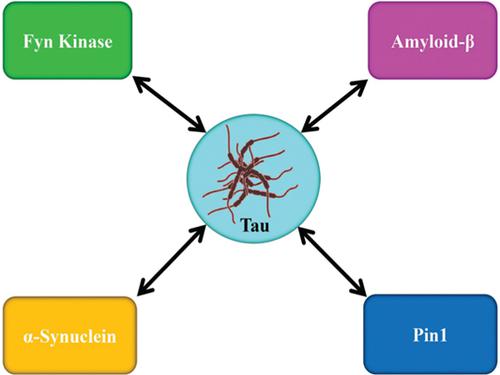Current Topics in Medicinal Chemistry ( IF 2.9 ) Pub Date : 2020-09-30 , DOI: 10.2174/1568026620666200601161703 Md Sahab Uddin 1, 2 , Abdullah Al Mamun 1, 2 , Md Ataur Rahman 3 , Tapan Behl 4 , Asma Perveen 5 , Abdul Hafeez 6 , May N Bin-Jumah 7 , Mohamed M Abdel-Daim 8, 9 , Ghulam Md Ashraf 10, 11

|
Objective: Alzheimer's disease (AD) is a devastating neurodegenerative disorder, characterized by the extracellular accumulations of amyloid beta (Aβ) as senile plaques and intracellular aggregations of tau in the form of neurofibrillary tangles (NFTs) in specific brain regions. In this review, we focus on the interaction of Aβ and tau with cytosolic proteins and several cell organelles as well as associated neurotoxicity in AD.
Summary: Misfolded proteins present in cells accompanied by correctly folded, intermediately folded, as well as unfolded species. Misfolded proteins can be degraded or refolded properly with the aid of chaperone proteins, which are playing a pivotal role in protein folding, trafficking as well as intermediate stabilization in healthy cells. The continuous aggregation of misfolded proteins in the absence of their proper clearance could result in amyloid disease including AD. The neuropathological changes of AD brain include the atypical cellular accumulation of misfolded proteins as well as the loss of neurons and synapses in the cerebral cortex and certain subcortical regions. The mechanism of neurodegeneration in AD that leads to severe neuronal cell death and memory dysfunctions is not completely understood until now.
Conclusion: Examining the impact, as well as the consequences of protein misfolding, could help to uncover the molecular etiologies behind the complicated AD pathogenesis.
中文翻译:

多因素阿尔茨海默氏病中蛋白质错误折叠和相互作用的新兴证据。
目的:阿尔茨海默氏病(AD)是一种毁灭性的神经退行性疾病,其特征是淀粉样β(Aβ)的细胞外积累为老年斑和tau的细胞内聚集,形式为特定大脑区域的神经原纤维缠结(NFT)。在这篇综述中,我们集中于Aβ和tau与胞质蛋白和几种细胞器的相互作用以及与AD相关的神经毒性。
摘要:细胞中存在错误折叠的蛋白质,并伴随着正确折叠,中间折叠以及未折叠的物种。可以在伴侣蛋白的帮助下正确折叠或错误折叠蛋白,这些蛋白在健康细胞中的蛋白折叠,运输和中间稳定中起着关键作用。错误折叠的蛋白质在没有适当清除的情况下持续聚集可能会导致淀粉样变性病,包括AD。AD脑的神经病理学变化包括错误折叠的蛋白质的非典型细胞蓄积,以及大脑皮层和某些皮质下区域中神经元和突触的丢失。迄今为止,AD中导致严重神经元细胞死亡和记忆功能障碍的神经退行性机制尚不完全清楚。
结论:检查蛋白质错折叠的影响以及后果,可能有助于揭示复杂的AD发病机制背后的分子病因。











































 京公网安备 11010802027423号
京公网安备 11010802027423号